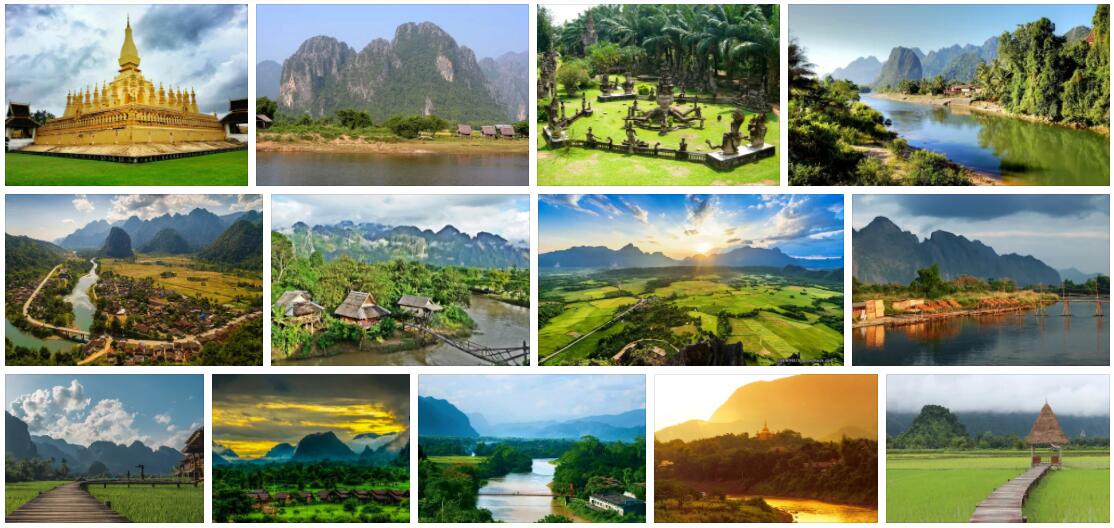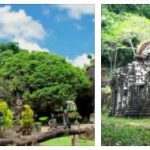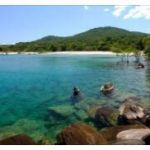| Sathalanalate Paxathipatai Paxaxon Lao | |
| Official language | Lao |
| Capital | Vientiane |
| Form of government | People’s Democratic Republic |
| Area | 236,800 km² |
| Residents | 6,150,000 |
| Currency | Kip |
| Time zone | UTC + 7 |
| License plate | LAO |
| Internet TLD | .la |
| Telephone area code | 00856 (Source: ALLCITYCODES) |

Geography
The Democratic People’s Republic of Laos is located in Southeast Asia and covers an area of 236,800 km2, about two thirds of the area of Germany. The country borders China in the north, Vietnam in the east, Cambodia in the south and Thailand and Myanmar in the west. See Laos country abbreviation.
Laos is mostly mountainous, only about 10% of the country’s area consists of lowlands or basin landscapes. In the north there are densely forested mountain ranges with heights of up to 2,000 m, which are very impassable due to deep valley cuts and gorges. Between the individual peaks are plateaus such as the Tran Ninh plateau, which is around 1,200 m above sea level. In the north of the country there is also the highest peak, the Phou Bia at 2,820 m. The east of Laos is characterized by the Annamite Cordillera, the peaks of which reach heights of up to 2,000 m and form the border with neighboring Vietnam. To the west, the country slopes down in terraces to a height of approx. 500 m.
In the southwest are the fertile lowlands of the country around the Mekong River. The Mekong is one of the largest rivers in Southeast Asia (4,500 km in total), rises in the highlands of Tibet and flows into the South China Sea in Vietnam. The Mekong and its numerous, often fast-flowing tributaries play a very important role in the irrigation of agricultural land and for electricity generation in Laos. The capital Vientiane (Viangchan) is located in the northwest of the country on the Mekong.
Climate
In Laos there is a tropical monsoon climate with year-round high temperatures and a pronounced rainy season: from May to October, the southwest monsoon brings in humid air masses, on average between 1,000 mm and 2,000 mm of precipitation are measured annually, in the mountainous regions it can be up to 4,000 mm. The months of November to February are low in rain, the northeast monsoon ensures somewhat cooler temperatures: average temperatures in the north of the country are around 15 °C in January, and 23 °C in the south. In July the average is 28 °C in the north and 30 °C in the south. Hottest month is the rainless April.
Flora and fauna
About 50% of the country’s area is covered with tropical forests. Deciduous monsoon forest can be found in the south and evergreen rain and mountain forest in the rainy regions in the north. Some of the plateaus in the northern mountainous region have savannas.
The animal kingdom is as rich in species as the country’s flora. The dense forests and inaccessible mountain landscapes offer a suitable habitat for many animals that are already considered extinct in other countries. Rare species include the Java rhinoceros and the Siamese lyre. Tigers, leopards, various types of monkeys and tapirs also live in the country. There are numerous elephants that are particularly protected as sacred animals.
Population
A total of around 6.15 million people live in Laos, most of them in the lowlands of the Mekong, while many mountain regions are practically uninhabited. Around 20% of the population live in cities, the capital Vientiane is by far the largest city in the country with 530,000 residents. There are around 70 peoples in Laos, which are divided into three large groups: The largest share of the total population is made up of the Lao-Lum (68%), who belong to the Thai people and form the state-supporting people. The second largest group are Lao-Theung (22%), whose traditional habitat is the mountainous regions of the country and the descendants of the Mon and Khmer.
According to COUNTRYAAH, the third large group is the Lao-Soung (9%), the Lao mountain peaks, which are divided into many different peoples and whose ancestors immigrated mainly from China. Chinese, Vietnamese and members of Indian peoples form only small minorities in Laos. The official language is Lao, which is one of the Thai languages. Almost two thirds of the population are followers of Buddhism, almost a third practice animistic religions. Christians and Muslims are religious minorities.
The standard of living in Laos is low, there is no state social security system and no comprehensive medical care; the average life expectancy is therefore only 55 years, the population growth is 1.7%. On average, every woman has five children. The literacy rate – especially among women – is still very low; only two thirds of Laotians can read and write. HIV / AIDS is a growing problem.
Political system
According to the constitution of August 1991, Laos is a People’s Democratic Republic, with the communist government party LRVP (Lao Revolutionary People’s Party) being the only political party allowed. The head of state is the President elected by the National Assembly for five years (Choummaly Sayasone since June 2006). He appoints the cabinet after approval by the National Assembly. The Prime Minister (since December 2010 Thongsing Thammavong) is appointed by the President after recommendation by the National Assembly and presides over the Council of Ministers (term of office five years).
The National Assembly consists of a chamber with 132 seats; the members are elected by the people for a term of five years.
Laos is divided into 16 provinces and the prefecture of Vientiane.
Economy
Laos is one of the fastest growing economies in the world. The Laotian government has successfully liberalized the economy since the mid-1980s; growth of up to 9% has been achieved in recent years. However, this high rate of increase is based on a very low basis. 27% of Laotians still live below the poverty line.
The most important industry in Laos is agriculture. Three quarters of all employed people work here, a third of the gross domestic product is generated in this way. The main crops are rice, cassava, sweet potatoes, vegetables, coffee, sugar cane, tobacco, cotton, tea and peanuts. Forestry is of great importance.
Industry is slowly increasing its productivity and is now responsible for 35% of GDP. The strong demand for mining products (especially gold, copper and iron ore) and the export of electricity are driving growth. The practically non-existent infrastructure and the small number of trained workers represent major obstacles for industry.
The Asian Free Trade Area (AFTA), founded in 1994, includes all ten member states of the ASEAN (Association of South-East Asian Nations) and thus also Laos. The ASEAN Free Trade Agreement entered into force in 2002. The most important trading partner for exports (copper, agricultural and forestry products, clothing) and for imports (machines, vehicles, industrial goods, precious metals) is Thailand, followed by China and Vietnam.
The road network covers a total of around 13,000 km, only a fraction of which is paved. There is an international airport near the capital Vientiane.
The Lao currency is the kip.







